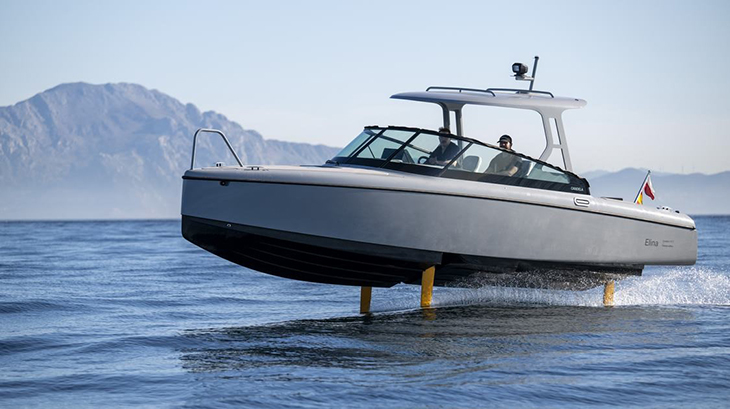

In a remarkable demonstration of what clean, electric-powered marine travel can achieve, a pioneering electric ferry has successfully crossed from Spain to North Africa and back — completing both trips within the same day.
The journey marks a significant breakthrough for sustainable maritime transport, proving that even challenging, high-traffic sea routes like the Strait of Gibraltar can be traversed reliably and efficiently without emitting a single gram of carbon emissions.
This milestone voyage wasn’t just about reaching a destination; it was about showing the world that decarbonizing ferry routes is no longer a distant ambition but a very real, present-day possibility.
The Swedish-built electric vessel departed from Sotogrande, Spain, bound for Ceuta, a Spanish city perched on the North African coast. The 24-nautical mile crossing was completed in just over an hour, matching the travel time of conventional fast ferries powered by diesel engines.
After docking in Ceuta, the vessel recharged before embarking on the return trip to Spain later the same day — a feat that proves electric ferries can realistically handle both commuter and tourism traffic on one of the world’s busiest maritime corridors.
For those following advancements in electric sea travel, this achievement builds on the successful rollout of the Candela P-12 electric ferryboat, which entered service within Stockholm’s public transport system in 2023. That vessel impressed early on by passing all its performance tests, clocking speeds of up to 30 knots per hour while maintaining a 50-nautical mile range per battery charge.
This latest voyage, however, marks the first-ever intercontinental sea crossing by an all-electric boat, signaling a new era for eco-friendly maritime technology.
According to Gustav Hasselskog, CEO of Candela and the pilot for this historic crossing, there’s a growing need for sustainable alternatives in Mediterranean transportation.
“There’s a clear need for additional fast, clean, and efficient travel options across the Mediterranean—and for direct lines that wouldn’t be economically viable with larger, conventional vessels,” said Hasselskog. He further emphasized Candela’s goal to integrate with, rather than replace, existing ferry services.
“We can help meet this demand, working alongside existing operators and ferries to boost connectivity and cut emissions—not just across the Strait but also along the coast, for example connecting cities along the Costa del Sol,” he added.
The vessel that accomplished this journey was the Candela C-8 Polestar edition, equipped with a 67 kWh battery pack identical to the one found in Polestar’s electric SUV — a brand under Volvo’s automotive umbrella.
This model was specifically designed with smaller, underserved coastal communities in mind — the kind that often sit too far from the major ferry terminals used by large, diesel-powered car ferries operating along the strait. For these regions, the Candela C-8 offers a cost-effective, zero-emission solution for short to mid-range crossings, making it an ideal fit for local tourism, commuter services, and private travel.
What truly sets the Candela C-8 apart is what lies beneath the water’s surface. The boat rides atop two hydrofoils — wing-like structures submerged beneath the hull. As the vessel picks up speed, these hydrofoils lift the boat above the water, reducing drag and drastically cutting down on energy consumption.
This hydrofoil system allows the electric ferry to use 80% less energy than traditional fast boats of similar size, making long-range electric crossings not just possible, but economically viable.
The crossing of the Strait of Gibraltar presented a particularly tough challenge. Known for its strong currents, unpredictable waves, and the intersection of the cold Atlantic Ocean with the warmer Mediterranean Sea, the strait can be difficult for even large ships, let alone smaller vessels like the Candela C-8.
To navigate such challenging conditions, Candela equipped the C-8 with an advanced computer-controlled hydrofoil system. Often dubbed a “magic pill” for motion sickness, this system uses real-time data from sensors measuring waves, wind, and currents to adjust the boat’s hydrofoils up to 100 times per second.
The result is a uniquely smooth and stable ride — so smooth, in fact, that passengers might feel like they’re gliding through the air rather than skimming over water. This feature makes the C-8 an appealing choice for routes known for choppy seas and for travelers prone to seasickness.
Beyond environmental benefits, the economic case for electric ferries like the Candela C-8 is also compelling. During the entire voyage, the boat consumed just 40 kWh of energy — equivalent to around $10 worth of electricity.
To put that in perspective, a similarly sized gasoline-powered boat performing the same trip would have burned more than 10 gallons of fuel, costing approximately $100. This massive difference in operating costs highlights the financial viability of electric maritime travel, especially on frequently traveled or commuter-heavy routes.
This successful intercontinental electric ferry crossing marks an important step forward for sustainable sea travel, demonstrating that it’s entirely possible to reduce emissions on even the world’s busiest maritime routes without sacrificing speed, reliability, or passenger comfort.
As climate concerns push industries toward decarbonization, Candela’s technology offers a realistic and scalable solution for short and mid-range crossings. From local routes along the Costa del Sol to busy strait crossings between Europe and Africa, vessels like the Candela C-8 and P-12 are poised to change the way we think about marine travel — proving that clean, efficient, and profitable options are no longer on the horizon; they’re already here.
See this electric boat make its historic crossing in the video below:
What are your thoughts? Please comment below and share this news!
True Activist / Report a typo







